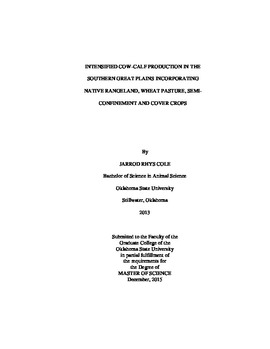| dc.contributor.advisor | Lalman, David | |
| dc.contributor.author | Cole, Jarrod | |
| dc.date.accessioned | 2017-02-22T22:12:30Z | |
| dc.date.available | 2017-02-22T22:12:30Z | |
| dc.date.issued | 2015-12-01 | |
| dc.identifier.uri | https://hdl.handle.net/11244/48971 | |
| dc.description.abstract | Decreasing acres of grazing land along with increasing demand in red meat suggests the need for intensified beef cattle production systems. The objective of the two year trial was to decrease land area per unit of production while maintaining or improve calf performance by economically incorporating semi-confinement and cropland into a fall-calving operation. Angus and Angus x Hereford cows were allotted randomly by BW and age into two forage system treatments: extensive (EXT) or intensive (INT). Cows assigned to the EXT treatment were continuously grazed on native rangeland at a low stocking rate. Cows assigned to the INT system were fed prairie hay and mineral supplement in a dry-lot through the winter. During this time, INT cows had access to 0.3-0.4 ha of wheat pasture per cow-calf unit 6 to 12-h/wk. Calves were allowed continuous access to wheat through creep gates. Following limit grazing, cows and calves were given free-choice access to wheat pasture. At the conclusion of graze-out, INT cows were moved to native rangeland with a stocking rate of 2.6-3.3 ha/cow-calf pair. Late summer after weaning in year 1, cows and steer calves grazed sorghum-sudan, and year 2 INT weaned calves grazed crabgrass. Data were analyzed using the GLIMMIX procedure of SAS. Pen was the experimental unit and the model included treatment, gender (when appropriate) and the interaction as fixed effect. Cow age was a random effect. During the limit grazing winter period EXT system cows lost substantially more weight and body condition compared to INT system cows (P < 0.01). As expected, calves limit grazing wheat pasture gained better than calves grazing native range (P = 0.02). Although, calf weight differences were narrowed, increased winter weights were maintained through the summer. At weaning, INT system calves were heavier both years. The annual cow cost was higher for INT system cows. However, calf revenue at weaning was higher for INT calves. The INT system cows raised heavier calves on less land. High annual cow costs from year 1 prompted an increase in stocking rate and change in summer crop to decrease individual cow cost in year 2. | |
| dc.format | application/pdf | |
| dc.language | en_US | |
| dc.rights | Copyright is held by the author who has granted the Oklahoma State University Library the non-exclusive right to share this material in its institutional repository. Contact Digital Library Services at lib-dls@okstate.edu or 405-744-9161 for the permission policy on the use, reproduction or distribution of this material. | |
| dc.title | Intensified Cow-calf Production in the Southern Great Plains Incorporating Native Rangeland, Wheat Pasture, Semi-confinement and Cover Crops | |
| dc.contributor.committeeMember | Warren, Jason | |
| dc.contributor.committeeMember | Doye, Damona Grace | |
| dc.contributor.committeeMember | Horn, Gerald | |
| osu.filename | Cole_okstate_0664M_14451.pdf | |
| osu.accesstype | Open Access | |
| dc.description.department | Animal Science | |
| dc.type.genre | Thesis | |
| dc.type.material | text | |
